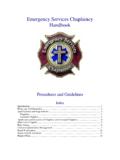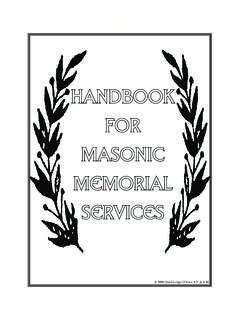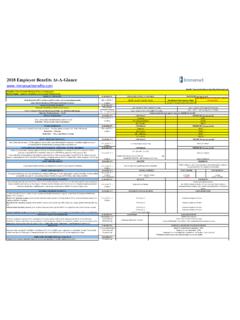Transcription of Handbook for Eucharistic Ministers and Eucharistic …
1 Handbook for Eucharistic Ministers and Eucharistic Visitors Table of Contents Forward by The Rt. Rev'd Daniel W. Herzog [ ]. Part I: Being Called & Equipped [p. 3]. Part II: Introduction to Lay Ministries [pp. 4-6]. A. Lay Ministries in the Church: A Brief Overview B. Lay Ministries in Canon Law C. Our Part in Ministering To Others Part III: Eucharistic Visitors [pp. 7-14]. A. Biblical Reflections and Background 1. The Call to minister 2. The Eucharistic Visit: An Expression of the Communion of the Saints 3. Understanding Others and Ourselves 4. Practical Ways of Communicating God's Loving Care B. The Nuts & Bolts of Eucharistic Ministry 1. Equipment and Materials 2.
2 First Things First 3. Getting Ready 4. The Rite 5. Setting Up 6. Record Keeping 7. Afterwards C. Frequently Asked Questions Part IV: Eucharistic Ministers [pp. 15-18]. A. Introduction B. The Nuts & Bolts of Being a Eucharistic minister 1. Before the Sunday Service 2. At Church on the Lord's Day 3. During the Liturgy C. Frequently Asked Questions Part V: Getting Started In Your Parish [pp. 19-22]. A. Education and Preparation of the Parish 1. Eucharistic Visitors 2. Eucharistic Ministers B. Selection and Training 1. Selection 2. Suggested Training Activities for Eucharistic Ministers 3. Suggested Training Activities for Eucharistic Visitors C.
3 Supervision and Evaluation Part VI: Text: Communion for the Sick & Shut-Ins [pp. 23-25]. Part VII: Appendices [pp. 26-29]. A. Title III, Canons 1 & 4 of the Episcopal Church B. Canon XI of the Diocese of Albany, NY. C. Form: Record of Communions 1. Forward by The Rt. Revered Daniel W. Herzog This Handbook for Eucharistic Ministers and Visitors has been prayerfully written and developed in response to the need in the Albany Diocese for a resource for both lay persons who engage in this pastoral ministry and clergy who are responsible for the training and equipping them. In addition to providing a unified and common curriculum for Eucharistic Ministers and Eucharistic Visitors in our diocese, this Handbook provides a standard liturgical form for the use of all Eucharistic Visitors in the Diocese.
4 All the materials in this Handbook reflect the changes in the National Canons 2003 regarding lay ministries. An important feature of this Handbook is its Biblical and spiritual focus: its emphasis throughout on being a committed disciple of Jesus Christ in order to be an effective minister . Our belief that the Eucharist is the true Body and Blood of Jesus compels this focus. This Handbook written by Deacon Richard Lehmann, Archdeacon Harvey Huth and Deacon Ludwig Wallner was first introduced at a Workshop at the 2006 Diocesan Convention. This updated edition incorporates the valuable suggestions from that Workshop. 2. Part I. Being Called & Equipped This Handbook is intended as a resource both for those who are being trained to be Eucharistic Visitors or Ministers and for those who are training them.
5 Whether you are a neophyte or seasoned Eucharistic minister or Visitor, there are always opportunities to learn more, develop or improve skills and become more proficient in how we serve God and His Church. It is hoped that what is written here will be useful and instructive for you at various stages along the way in your life of service as a disciple of Christ Jesus the Lord. The ways in which each of us becomes involved in the Church's ministry as a Eucharistic minister or Visitor vary. For some of us, there was an inner sense that this is what I ought to do and we asked our Deacon or Rector about becoming involved in this ministry. Others were asked by their Priest, Deacon or Warden to fill a need in the parish.
6 Beyond the circumstance of how we begin our involvement in lay ministry is the reality that we have been called by God to do so. Jesus' words to His first disciples apply to us as well: You did not choose Me but I chose you. [John 15:16]. By our obedience to that call, and by our active involvement in the ministry to which He has called us, we are sharing in the ministry of the Body of Christ, the Church. Now may the God of peace who brought again from the dead our Lord Jesus, the great shepherd of the sheep, by the blood of the eternal covenant, equip you with everything good that you may do his will, working in us that which is pleasing in his sight, through Jesus Christ, to whom be glory forever and ever.
7 Amen. Hebrews 13:20-21. 3. Part II. Introduction to Lay Ministries As each has received a gift, employ it for one another, as good stewards of God's varied grace: whoever speaks, as one who utters oracles of God; whoever renders service, as one who renders it by the strength which God supplies;. in order that in everything God may be glorified through Jesus Christ. 1 Peter 4:10-11. A. Lay Ministries in the Church: A Brief Overview 1. Lay Ministries in the Church have witnessed tremendous growth following the liturgical renewal of Vatican II in the Roman Catholic Church [1962-65] and the revision of our own Book of Common Prayer [1979]. What was once a new and innovative paradigm shift in the way the Church thinks about and does ministry has now become accepted and even commonplace in most American parishes and churches.
8 Yet the theology behind the raising up of lay Ministers in the Church is actually nothing new because it is thoroughly Biblical and is rooted in our Christian Tradition. St. Paul's teaching concerning the Body of Christ [Romans 12:3-8; 1. Corinthians 12-14; Ephesians 4:1-16] clearly outlines that all Baptized Christians are called to specific and mutually complementary ministries within the Church. In the Church there were to be no spectators. We are all called to serve. This is reflected in the teaching of the Prayer Book. The Catechism in the BCP. [ ] states: The Ministers of the Church are lay persons, bishops, priests, and deacons. It then outlines the scope and focus of lay ministry: The ministry of lay persons is to represent Christ and his Church; to bear witness to him wherever they may be; and, according to the gifts given them, to carry on Christ's work of reconciliation in the world.
9 And to take their place in the life, worship, and governance of the Church. From a Biblical and theological perspective, each and every Baptized Christian being called and empowered for active ministry should be normative for the 1. For a fuller overview of the history of Eucharistic Ministers , a good resource is Beth Wickenberg Ely's A Manual for Lay Eucharistic Ministers , 3rd printing (1993) pp. 1-8. 4. Church. Lay ministry is simply an expression of the Church's overall ministry as the Body of Christ. As such, the ministries to which we are called are not ours but more properly Christ's Own ministry in His Church through us. B. Lay Ministries in Canon Law The ministry of lay persons in the celebration and administration of the Holy Eucharist has certainly expanded in recent years.
10 In the American Book of Common Prayer (1928), a lay person was allowed to read the Epistle [New Testament Lesson] and nothing else. Prior to the current lay ministry canons, specially licensed lay readers administered the chalice at the Eucharist and were known as "chalice bearers.". No provision was made for the administration of the host by lay persons under any other circumstances. Nothing in the 1979 prayer book permitted lay persons to carry elements to persons unable to be present at the celebration of the Holy Eucharist. The rubrics in the Service of Communion Under Special Circumstances indicate that communion will be brought to the sick only by a bishop, priest, or deacon.








